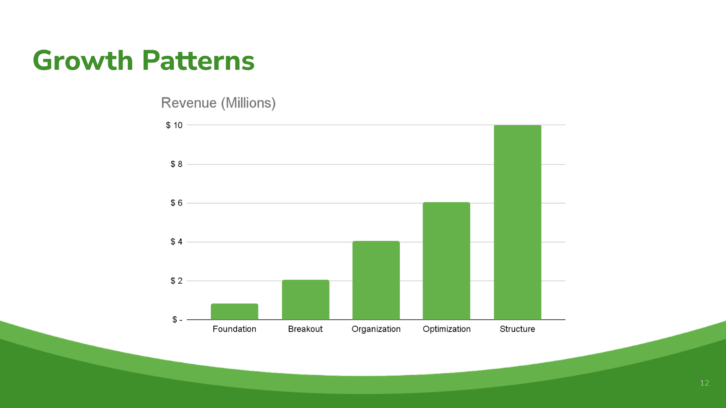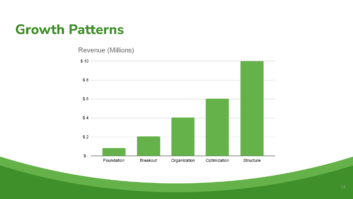[EDITOR’S NOTE: VITAL holds monthly CI Business Mastery Classes where it addresses important CI business topics via a webinar. Each class is supported by an industry brand. VITAL has agreed to share some of the information from these classes in a monthly column of highlights from its most recent webinar. The tenth CI Business Mastery Class was on optimizing the CI business model, and it was supported by Crestron.]
Today, we’re going to look at the CI business model from a macro perspective. We commonly see five growth patterns throughout the industry: Foundation, Breakout, Organization, Optimization, and Structure.

Foundation
These are companies that earn up to $800,000 or, in some cases, $1 million. We commonly see in this space between one to five employees, often four or fewer. The owner is usually doing it all — selling, managing, ordering, installing —whatever is needed to keep things going, putting on different hats all day long.
For a business to grow beyond Foundation, there are a number of key factors to focus on. One of the most important and underrated hires at this size is a good admin. In fact, many integrators will struggle to have a solid integration company without an amazing admin person. Many dealers make the mistake of waiting way too long to hire that admin person, or they make the mistake of choosing someone without the right skill set. At this size, you’re going to need a bit more of a generalist for that role — somebody who can manage a lot of different things in different ways. The goal of an admin at this size is to take as much off the owner’s plate as possible. This is also a good time for the owner to learn more about his or her strengths and hire people to fill in the gaps.
Breakout
We refer to businesses in the $1 to $2 million range to be in the Breakout phase because the average integrator simply does not reach this benchmark, when you look at the industry as a whole. This is where integrators start to break out and have the opportunity to keep going beyond the $2 million mark. The owner has realized how to delegate some tasks, found a little magic, and truly has the opportunity to continue to build a solid business. You need to mentor the admin at this point to take on more responsibilities and become an office manager. The admin now needs to start taking on purchasing, warehouse management, and possibly bookkeeping responsibilities.
There needs to be a focus on relationship-building at this size. The owner is still selling most, if not all, the projects and sometimes there’s such a focus on selling that relationship-building takes a backseat. Don’t let that happen. To grow beyond this point, you need to continue to build those partner relationships. This is the size of business where the sales process needs to become more well-defined because there will be a point of growth where the owner can no longer be the only salesperson. Start thinking about documenting the sales process. For you to grow beyond this $2 million and 10-employee stage, you really need to be hiring. At this point in your growth phase, you need to be hiring people at the bottom of your organization and training them. This provides mentorship opportunities for your tenured staff, growth opportunities for others, while creating space for top-grading if needed.
Organization
Next up is Organization — the $2 to $6 million, 10- to 20-employee-sized company. While we have worked with many over the years, across our industry fewer companies reach this size. It is a very profitable and sustainable model. The reason we call this growth level “Organization” is because, for a company to sustain at this size and be optimized without driving the owner into the grave, there needs to be a level of organization.
If you want to continue to grow and drive through this chasm to the next growth level, there needs to be a focus on documenting processes and standards. This is where you go from organization to optimization. You must continue to reduce friction throughout the entire business and focus on overall productivity and efficiency in the company.
This is the point where we truly need leadership throughout the organization. We can’t just have the one sole bottleneck leader in the company. We need to develop our leaders throughout the organization and make sure that we’re hiring for a culture fit because, at this size, you truly have a living and breathing culture that you must maintain as you grow.
Here, you start to see more sophistication developing on the sales side. This must be intentional in the way you hire, develop, and manage sales talent to reach and sustain this size. This is where you can see a junior sales role starting to make sense. This junior salesperson provides support for the salespeople and is learning the ropes as he or she moves up through the sales side of the organization. Engineers are a key factor in reducing the sales friction and improving the overall in-field productivity by creating better plans and documentation to allow those installers and the production staff to be more effective.
Structure
A very small percentage of dealers throughout the industry will grow beyond the $6 million revenue stage, and many of the dealers we’ve met at this size are producing less than double-digit net profit as their businesses become more complex and they add more unbillable staff to the mix. This is not an inevitable byproduct of growth, however, and we do start to see some new roles pop up in these larger companies due to the nature of the business. You’ll start to see more and more specialization of roles as the amount of work increases.
The key to growing in a profitable way, especially at this size, is to create structure, reduce chaos, and focus on financial efficiency and leverage. Leverage means doing more with what you have, which is producing the greatest top-line and bottom-line outcomes from the staff that you already have while continuing to top grade and always be hiring. That’s why we’ve coined this growth level as “Structure,” because without intentional structure and efficiency, there is so much work to be done at very little profit.
Takeaways
The most important factor, no matter what growth level you’re at, is the people and leadership of these people. It’s critical to look ahead and remember a few key elements along the growth journey.
As you climb the staircase of company growth, make sure you stop at the landing and optimize your business before moving on to the next level. That stop could be months or years, but you need to make sure to optimize because revenue does not always fix the problems. In fact, revenue can often hide the problems.
Also remember that revenue is for vanity and profit is for sanity. Revenue is important and it’s key, but bottom-line profit is what’s going to help take you to the next level and allow you to reinvest in your team and create lasting opportunity for you and your staff.
Growth is always going to consume cash, especially in the business that we’re in, and it’s crucial to have all your cash metrics and understand where your money is going and how to put it to work for you.
Lastly, as you proceed through these different growth levels, it’s important to know that you will outgrow some of your people. And some of your people will grow out of you and your business. This can be unsettling because we need these people to get the work done and we truly like and love these folks. Sometimes it can be difficult to part ways with them, but know that if you don’t move on, you will be held back.
Imagine you operated an art gallery, and each weekend you sold through several your most popular paintings. The following week you filled the holes with new paintings, and the pattern continued week after week. Unless you did something with the paintings that did not sell, you would eventually have a gallery full of paintings that nobody wants. Great employees are like popular paintings, they are always in demand and on the move. You want to retain them as long as possible and provide them opportunities to grow while they are with you. Underperforming employees are not in demand, and they will stick around in your business like ugly paintings on the wall of a gallery until someone does something about them. It’s okay to outgrow some of your staff, it’s also okay for your staff to outgrow you. Your job as a leader is to always be growing and grooming your team, just like the owner of an art gallery curates the offerings on display.
For more information about the CI Business Mastery Classes and the other services VITAL provides, visit http://growwithVITAL.com.






